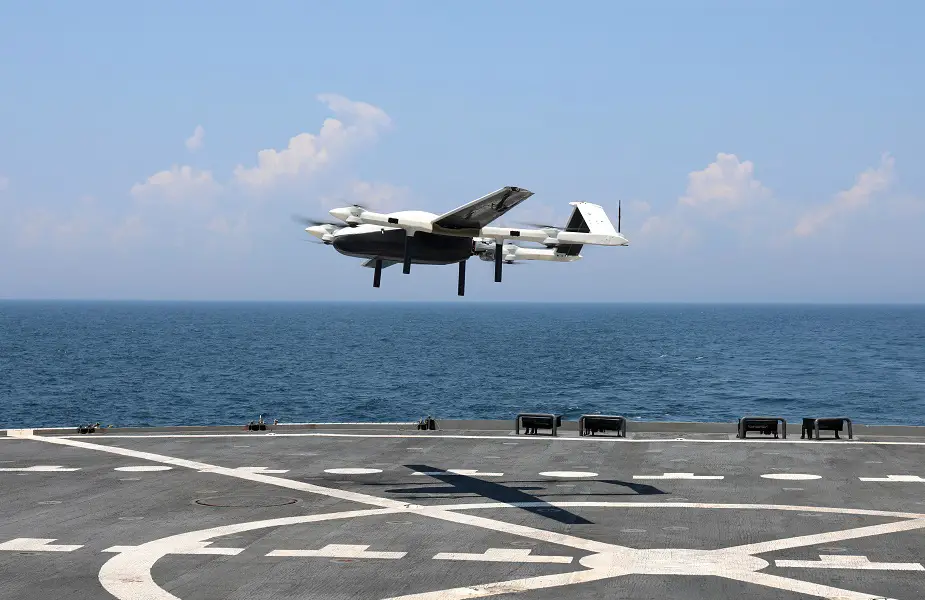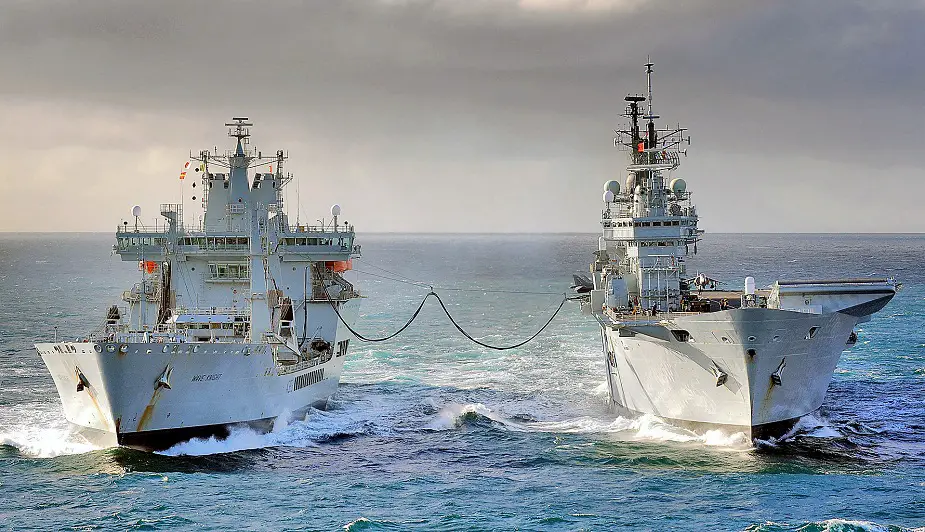Breaking news
UK: Royal Navy looks to drones to deliver lightweight supplies at sea.
The Royal Fleet Auxiliary (RFA) – whose ships and sailors have supported Royal Navy operations since 1905 with fuel, food, spare parts, ammunition and other supplies – is looking into the possibility of crewless aircraft performing some of the more routine, lighter duties.
Follow Navy Recognition on Google News at this link

Using drones would save time, money and sailors, and free up helicopters for other duties (Picture source: Royal Navy)
The classic image of the Royal Fleet Auxiliary is of a tanker sailing parallel with a warship and either pumping fuel into its tanks via a hose, or transferring supplies in crates and on pallets on a jackstay line slung between the two vessels. But helicopters are also used extensively to move loads around the fleet, typically in large nets carried beneath the aircraft.
During the recent Carrier Strike Group deployment supporting HMS Queen Elizabeth’s mission to the Pacific and back, supply ship RFA Fort Victoria shipped nearly 900 loads to the carrier and other ships in the task group, encompassing food and drink, general stores, spare parts, medical supplies, mail and parts for F-35 stealth fighters and Merlin and Wildcat helicopters – over 354 tonnes of supplies in all – while tanker RFA Tidespring carried out 67 ‘vertical replenishments’ as they are known.
While some loads are too heavy for current small-scale drones to transport, seven out of ten resupply missions involve the transfer of loads up to 100lbs/45kg, so the head of the RFA, Commodore David Eagles, wants to see if the work is ‘dronable’.
 Royal Navy aircraft carrier HMS Ark Royal conducts a Replenishment at Sea (RAS) with the supply vessel RFA Wave Knight in the North Sea (Picture source: Royal Navy)
Royal Navy aircraft carrier HMS Ark Royal conducts a Replenishment at Sea (RAS) with the supply vessel RFA Wave Knight in the North Sea (Picture source: Royal Navy)
Using drones would save time, money and sailors, and free up helicopters for other duties.
The US Navy’s Naval Air Systems Command is experimenting with unmanned aircraft moving relatively lightweight supplies – up to 25lbs/11kg – between ships, but over distances which could be greater than 200 miles.
Trials over the summer successfully proved this concept by delivering a small cargo for repairs between a warship and an auxiliary of the Military Sealift Command – the US Navy’s equivalent of the RFA.
Royal Marines have tested re-supply by drone both on the battlefield and on the beachhead, using autonomous systems, from Malloy Aeronautics Ltd, to ferry up to 150lbs/68kg supplies; including ammunition, blood and Bergen backpacks to troops in the line from either ships off shore or bases to the rear.

A drone delivering medical supplies to Royal Marin on exercise in the field (Picture source: Royal Navy)
“The RFA is looking very closely at the Military Sealift Command and the opportunities around using drones to make deliveries at sea,” said Commodore Eagles.
The RFA Commodore regularly confers with his counterpart in the MSC, Rear Admiral Michael Wettlaufer, which conducted the summer trials; and he has asked his liaison team to follow their progress and share some lessons of the Royal Navy’s own trials with similar systems.
The RFA ends 2021 on something of a high after rising to all the challenges made of it this year – notably sustaining the carrier group half-way around the world in the middle of a pandemic which impacted moving supplies and personnel.
Its ships delivered more than 65 million litres of fuel to vessels from six nations, as well as 16 million litres of aviation fuel, thousands of litres of fresh water and other goods.
Tanker RFA Wave Knight delivered aid to volcano hit St Vincent, supported US-led relief efforts off Haiti in the wake of the summer’s devastating earthquake and, in conjunction with the US Coast Guard, has seized 2½ tonnes of cocaine in five busts spread across the autumn.
Amphibious ship RFA Mounts Bay is assigned to the Royal Marines’ new Arctic-focused Littoral Response Group (North) and will also serve as the testbed for ongoing autonomous trials by the commandos.
And RFA Lyme Bay replaced her sister Cardigan Bay in the Gulf as the command ship for UK (and, when required, allied) minehunters, continuing a mission going back nearly 15 years.
“My message at the end of 2021 is resolutely positive – we have achieved what was asked of us this year,” said Commodore Eagles. “Our people and their families have delivered so much. We are in an extremely positive place going into 2022.”


























